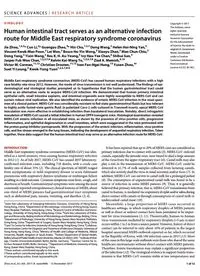
2017 Human intestinal tract serves as an alternative infection route for Middle East respiratory syndrome coronavirus PDF
Preview 2017 Human intestinal tract serves as an alternative infection route for Middle East respiratory syndrome coronavirus
Zhou et al., Sci. Adv. 2017; 3 : eaao4966 15 November 2017 SCIE N C E A D V A NCES | RESEA R CH A RT ICL E 1 of 12 VIROLOGY Human intestinal tract serves as an alternative infection route for Middle East respiratory syndrome coronavirus Jie Zhou,1,2,3* Cun Li,2* Guangyu Zhao,4* Hin Chu,1,2,3 Dong Wang,2 Helen Hoi-Ning Yan,5 Vincent Kwok-Man Poon,2 Lei Wen,2 Bosco Ho-Yin Wong,2 Xiaoyu Zhao,2 Man Chun Chiu,2 Dong Yang,2 Yixin Wang,2 Rex K. H. Au-Yeung,5 Ivy Hau-Yee Chan,6 Shihui Sun,4 Jasper Fuk-Woo Chan,1,2,3,7,8 Kelvin Kai-Wang To,1,2,3,7,8 Ziad A. Memish,9,10 Victor M. Corman,11,12 Christian Drosten,11,12 Ivan Fan-Ngai Hung,13 Yusen Zhou,4† Suet Yi Leung,5 Kwok-Yung Yuen1,2,3,7,8†‡ Middle East respiratory syndrome coronavirus (MERS-CoV) has caused human respiratory infections with a high case fatality rate since 2012. However, the mode of virus transmission is not well understood. The findings of epi- demiological and virological studies prompted us to hypothesize that the human gastrointestinal tract could serve as an alternative route to acquire MERS-CoV infection. We demonstrated that human primary intestinal epithelial cells, small intestine explants, and intestinal organoids were highly susceptible to MERS-CoV and can sustain robust viral replication. We also identified the evidence of enteric MERS-CoV infection in the stool speci- men of a clinical patient. MERS-CoV was considerably resistant to fed-state gastrointestinal fluids but less tolerant to highly acidic fasted-state gastric fluid. In polarized Caco-2 cells cultured in Transwell inserts, apical MERS-CoV inoculation was more effective in establishing infection than basolateral inoculation. Notably, direct intragastric inoculation of MERS-CoV caused a lethal infection in human DPP4 transgenic mice. Histological examination revealed MERS-CoV enteric infection in all inoculated mice, as shown by the presence of virus-positive cells, progressive inflammation, and epithelial degeneration in small intestines, which were exaggerated in the mice pretreated with the proton pump inhibitor pantoprazole. With the progression of the enteric infection, inflammation, virus-positive cells, and live viruses emerged in the lung tissues, indicating the development of sequential respiratory infection. Taken together, these data suggest that the human intestinal tract may serve as an alternative infection route for MERS-CoV. INTRODUCTION Middle East respiratory syndrome coronavirus (MERS-CoV) was iden - tified as a novel zoonotic virus causing human respiratory infection in 2012 (1). As of July 2017, MERS-CoV has caused 2037 laboratory- confirmed infection cases, including 710 deaths, with a crude case fatality rate of about 35% (2). The clinical spectrum of MERS ranged from asymptomatic or mild respiratory disease to acute fulminant pneumonia with respiratory distress syndrome or multiorgan failure resulting in a fatal outcome. Common symptoms were fever, cough, and shortness of breath. Gastrointestinal symptoms were among the most commonly reported extrapulmonary clinical features of MERS; about one-third of MERS patients had gastrointestinal tract symptoms such as abdominal pain, nausea, vomiting, and diarrhea (3, 4). It has been reported that up to 20% of MERS cases are considered as primary infections due to contact with camels (5). MERS-CoV–infected camels, especially the juvenile ones, were found to shed a large amount of the virus from the upper respiratory tract (6). Camel milk may also play a role in the transmission of MERS-CoV. MERS-CoV could be detected in 41.7% of milk samples collected from lactating camels, which also actively shed the virus in nasal secretion and/or feces (7). In addition, MERS-CoV can survive in camel milk for a prolonged period (8). The consumption of unpasteurized camel milk was found to be a source of infection in some MERS patients (9). Thus, it is generally believed that primary infection, that is, MERS-CoV transmission from camel to human, is mediated via respiratory droplet and/or saliva during direct contact with camels or through consumption of camel milk or undercooked camel meat (10). Meanwhile, a large proportion of MERS cases occurred in healthcare settings, in which respiratory droplets of MERS patients as well as direct or indirect contact have been postulated to be impor- tant for virus transmission (3, 11). Theoretically, human-to-human virus transmission mediated by respiratory droplets (>5 m in size) occurs within 1 to 2 m from a source patient. However, history of direct contact can be inferred in only about 10% of patients in the largest hospital-associated MERS outbreak reported so far, which occurred in the Republic of Korea, with 186 infection cases in 2015 (12). Most of the cases in this large-scale outbreak were those who shared the same healthcare environment without direct contact with MERS patients. Therefore, fomite transmission may explain a significant proportion of the infections (12). The virological evidence to support fomite trans- mission is that MERS-CoV remains stable at low temperatures and 1State Key Laboratory of Emerging Infectious Diseases, University of Hong Kong, Hong Kong, China. 2Department of Microbiology, University of Hong Kong, Queen Mary Hospital, Pokfulam, Hong Kong, China. 3Research Centre of Infection and Immu- nology, University of Hong Kong, Hong Kong, China. 4State Key Laboratory of Patho- gen and Biosecurity, Beijing Institute of Microbiology and Epidemiology, Beijing, China. 5Department of Pathology, University of Hong Kong, Queen Mary Hospital, Pokfulam, Hong Kong, China. 6Department of Surgery, Queen Mary Hospital, Hong Kong, China. 7Carol Yu Centre for Infection, University of Hong Kong, Hong Kong, China. 8Collabora- tive Innovation Center for Diagnosis and Treatment of Infectious Diseases, University of Hong Kong, Hong Kong, China. 9Ministry of Health and College of Medicine, Alfaisal University, Riyadh, Kingdom of Saudi Arabia. 10Hubert Department of Global Health, Rollins School of Public Health, Emory University, Atlanta, GA 30322, USA. 11Institute of Virol- ogy, Charité–Universitätsmedizin Berlin, Berlin, Germany. 12German Centre for In- fection Research (DZIF), Berlin, Germany. 13Department of Medicine, University of Hong Kong, Queen Mary Hospital, Hong Kong, China. *These authors contributed equally to this work. †These authors contributed equally to this work. ‡Corresponding author. Email:
